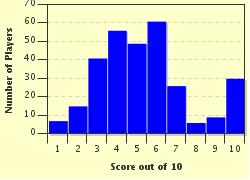Quiz Answer Key and Fun Facts
1. Please note that this quiz utilizes US standards and vitamin preparations for some questions.
According to a New England Journal of Medicine "Medical Progress" article (NEJM 2007;357:266-81) "vitamin D deficiency remains common in children and adults". In which of the following groups were more than 30% of people found to be vitamin D deficient?
2. Both diet and sun exposure can be a source for vitamin D. In fact, exposure to enough sunlight can provide 15 times the recommended amount of vitamin D for a child or young person. Which of the following does not influence the effectiveness of sun exposure in the production of vitamin D?
3. Vitamin D is of particular importance for the developing skeleton. Which of these is a consequence of childhood vitamin D deficiency?
4. Vitamin D deficiency has consequences in adults, particularly older adults. Which of the following is not known to be consequence of adult vitamin D deficiency?
5. Vitamin D is often thought of as a "bone vitamin" taken to reduce fracture risk. For which other conditions has higher vitamin D intake been found to correlate with reduced risk? The "association" has been demonstrated irrespective of cause and effect.
6. Only certain foods contain or are fortified with vitamin D. Which of the following would contain at least the United States National Institute of Health "adequate intake" for most children and adults?
7. The recommended dietary allowance for vitamin D differs with age. Which age group requires the greatest amount.
8. An older person is having difficulty reaching the recommended intake of vitamin D for his age group and is considering sun exposure as a means to obtain the necessary vitamin D. What is not a possible consequence of increased sun exposure?
9. You have decided to obtain your vitamin D from a vitamin D supplement. The label reads as follows:
Supplement Facts
Serving size 2 tablets
Amount per serving
Vitamin D 400 units
Which of the following will provide 800 units of Vitamin D?
10. Either vitamin D2 or vitamin D3 may be sold as "vitamin D" in over the counter vitamin products in the United States. How do the potency of vitamin D2 and vitamin D3 compare?
Source: Author
uglybird
This quiz was reviewed by FunTrivia editor
crisw before going online.
Any errors found in FunTrivia content are routinely corrected through our feedback system.

